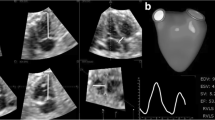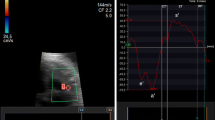Abstract
Myocardial performance index (MPI), or Tei index, has become a commonly used parameter for the noninvasive, Doppler-derived assessment of global systolic and diastolic performance of the heart in both adults and children. Normal values have been established in adults and children; however, limited data exist in fetal hearts. The aim of this study was to further elucidate normal values of fetal left (LV) and right ventricle (RV) MPI values in second- and third-trimester fetuses and compare these values with other previously published data. This was a retrospective study to measure MPI in healthy fetuses. After Institutional Review Board approval, 2000 fetal echocardiography studies (FES) were acquired during a period of 4 years. Demographic parameters examined included gestational age (GA), maternal age (MA), and indication for fetal echocardiography. Fetuses with congenital heart disease, arrhythmias, or significant noncardiac fetal anomalies were excluded. The following echocardiography parameters were collected: LV ejection time (LVET), mitral valve close-to-open time (MVCO), RVET, tricuspid valve CO (TVCO), and fetal heart rate. For simplicity, LV and RV MPI values were calculated as follows: LV MPI = MVCO − LVET/LVET and RV MPI = TVCO − RVET/RVET. Four hundred twenty FES met the study criteria. LV MPI was evaluated in 230 and 190 FES in the second and third trimester, respectively. Of the 420 FES, 250 (150 in the second trimester and 100 in the third trimester) had all of the measurements required for RV MPI calculation. MA ranged between 16 and 49 years. Indications for FES included diabetes mellitus (N = 140; 33 %), suspected fetal anomalies on routine obstetrical ultrasound (N = 80; 20 %), autoimmune disorder (N = 60; 14 %), family history of CHD (N = 76; 18 %), medication exposure (N = 22; 5 %), increase nuchal thickness (N = 13; 3 %), and other indications (N = 29; 6 %). Averaged LV and RV MPI values were 0.464 ± 0.08 and 0.466 ± 0.09, respectively. Further analysis based on gestational period showed slightly greater LV and RV MPI values during the third compared with the second trimester, i.e., 0.48 and 0.49, respectively, with no statistically significant difference. There was no significant association of LV and RV MPI with heart rate. To our knowledge, this is the first study to establish normal values of fetal MPI based on a large fetal population from a single tertiary center. LV and RV MPI values were independent of GA and fetal heart rate. MPI is a useful parameter for the assessment of global cardiac function in the fetus and demonstrates good reproducibility with narrow interobserver and intraobserver variability. Its usefulness should be studied in fetal hearts with complex congenital anomalies.



Similar content being viewed by others
References
Baysal T, Oran B, Doğan M, Cimen D, Karaaslan S (2005) The myocardial performance index in children with isolated left-to-right shunt lesions. Anadolu Kardiyol Derg 5(2):108–111
Blanchard D, Malouf P, Gurudevan S, Auger W, Madani N, De Maria A et al (2009) Utility of right ventricular Tei index in the non invasive evaluation of chronic thromboembolic pulmoanry thromboendartrectomy. JACC Cardiovasc Imaging 2(2):143–149
Carluccio E, Biagolo P, Alunni G, Murrone A, Zuchi C et al (2012) Improvement of myocardial performance index closely reflects intrinsic improvement of cardiac function: assessment in revascularized hibernating myocardium. Echocardiography 29(3):298–306
Chen Q, Sun XF, Liu HJ (2006) Assessment of myocardial performance in fetuses by using Tei index. Zhonghua Fu Chan Ke Za Zhi 41(6):387–390
Cheung MM, Smallhorn JF, Redington AN, Vogel M (2004) The effects of changes in loading conditions and modulation of inotropic state on the myocardial performance index: comparison with conductance catheter measurements. Eur Heart J 25(24):2238–2242
Comas M, Crispi F, Cruz-Martinez R, Martinez JM, Figueras F, Gratacós E (2010) Usefulness of myocardial tissue Doppler versus conventional echocardiography in the evaluation of cardiac dysfunction in early-onset intrauterine growth restriction. Am J Obstet Gynecol 203(1):45.e1–45.e7
Dolkart LA, Reimers FT (1991) Transvaginal fetal echocardiography in early pregnancy: normative data. Am J Obstet Gynecol 165(3):688–691
Dyer KL, Pauliks LB, Das B, Shandas R, Ivy D, Shaffer EM et al (2006) Use of myocardial performance index in pediatric patients with idiopathic pulmonary arterial hypertension. J Am Soc Echocardiogr 19(1):21–27
Eidem BW, Edwards JM, Cetta F (2001) Quantitative assessment of fetal ventricular function: establishing normal values of the myocardial performance index in the fetus. Echocardiography 18(1):9–13
Friedman D, Buyon J, Kim M, Glickstein JS (2003) Fetal cardiac function assessed by Doppler myocardial performance index (Tei Index). Ultrasound Obstet Gynecol 21(1):33–36
Gudmundsson S, Huhta JC, Wood DC et al (1991) Venous Doppler ultrasonography in the fetus with nonimmune hydrops. Am J Obstet Gynecol 164:33–37
Hamela-Olkowska A, Szymkiewicz-Dangel J (2011) Quantitative assessment of the right and the left ventricular function using pulsed Doppler myocardial performance index in normal fetuses at 18 to 40 weeks of gestation. Ginekol Pol 82(2):108–113
Haney MF, A’Roch R, Johansson G, Poelaert J, Biber B (2007) Beat-to-beat change in “myocardial performance index” related to load. Acta Anaesthesiol Scand 51(5):545–552
Hernandez-Andrade E, López-Tenorio J, Figueroa-Diesel H, Sanin-Blair J, Carreras E, Cabero L et al (2005) A modified myocardial performance (Tei) index based on the use of valve clicks improves reproducibility of fetal left cardiac function assessment. Ultrasound Obstet Gynecol 26(3):227–232
Hernandez-Andrade E, Crispi F, Benavides-Serralde JA, Plasencia W, Diesel HF, Eixarch E et al (2009) Contribution of the myocardial performance index and aortic isthmus blood flow index to predicting mortality in preterm growth-restricted fetuses. Ultrasound Obstet Gynecol 34(4):430–436
Ichizuka K, Matsuoka R, Hasegawa J, Farina A, Okai T (2005) The Tei index for evaluation of fetal myocardial performance in sick fetuses. Early Hum Dev 81(3):273–279
Inamura N, Taketazu M, Smallhorn JF, Hornberger LK (2005) Left ventricular myocardial performance in the fetus with severe tricuspid valve disease and tricuspid insufficiency. Am J Perinatol 22(2):91–97
Jurko A Jr, Jurko A, Minarik M (2011) Doppler-derived myocardial performance index in healthy children. Bratisl Lek Listy 112(2):77–79
Letti Müller AL, Barrios Pde M, Kliemann LM, Valério EG, Gasnier R, Magalhães JA (2010) Tei index to assess fetal cardiac performance in fetuses at risk for fetal inflammatory response syndrome. Ultrasound Obstet Gynecol 36(1):26–31
Mäkikallio K, Jouppila P, Räsänen J (2005) Human fetal cardiac function during the first trimester of pregnancy. Heart 91(3):334–338
Møller JE, Poulsen SH, Egstrup K (1999) Effect of preload alternations on a new Doppler echocardiographic index of combined systolic and diastolic performance. J Am Soc Echocardiogr 12(12):1065–1072
Pedra SR, Smallhorn JF, Ryan G, Chitayat D, Taylor GP, Khan R, Abdolell M, Hornberger LK (2002) Fetal cardiomyopathies: etiologies, hemodynamic findings and clinical outcome. Circulation 106:585–591
Raboisson MJ, Bourdages M, Fouron JC (2003) Measuring left ventricular myocardial performance index in fetuses. Am J Cardiol 91:919–921
Russell NE, McAuliffe FM (2008) First-trimester fetal cardiac function. J Ultrasound Med 27(3):379–383
Schmidt KG, Silverman NH, Hoffman JI (1995) Determination of ventricular volumes in human fetal hearts by two-dimensional echocardiography. Am J Cardiol 76:1313–1316
Simpson JM, Cook A (2002) Repeatability of echocardiographic measurements in the human fetus. Ultrasound Obstet Gynecol 20:332–339
Szwast A, Tian Z, McCann M, Donaghue D, Rychik J (2009) Right ventricular performance in the fetus with hypoplastic left heart syndrome. Ann Thorac Surg 87(4):1214–1219
Szymkiewicz-Dangel J, Hamela-Olkowska A, Własienko P, Jalinik K, Czajkowski K (2007) The possibility of evaluation of the myocardial performance index in fetuses at 11,0 to 13,6 week of gestation. Ginekol Pol 78(3):218–222
Tei C (1995) New noninvasive index for combined systolic and diastolic ventricular function. J Cardiol 26:135–136
Tsutsumi T, Ishii M, Eto G et al (1999) Serial evaluation for myocardial performance in fetuses and neonates using a new Doppler index. Pediatr Int 41:722–727
Turan S, Turan OM, Miller J, Harman C, Reece EA, Baschat AA (2011) Decreased fetal cardiac performance in the first trimester correlates with hyperglycemia in pregestational maternal diabetes. Ultrasound Obstet Gynecol 38(3):231–325
Van Mieghem T, Gucciardo L, Lewi P, Lewi L, Van Schoubroeck D, Devlieger R et al (2009) Validation of the fetal myocardial performance index in the second and third trimesters of gestation. Ultrasound Obstet Gynecol 33(1):58–63
Wladimiroff JW, Huisman TW, Stewart PA (1991) Fetal cardiac flow velocities in the late 1st trimester of pregnancy: a transvaginal Doppler study. J Am Coll Cardiol 17(6):1357–1359
Wong ML, Wong WH, Cheung YF (2007) Fetal myocardial performance in pregnancies complicated by gestational impaired glucose tolerance. Ultrasound Obstet Gynecol 29(4):395–400
Zerguini N, Leger P, Aubert S, Ray R, Ouattara A et al (2008) Tei index to assess perioperative left ventricular systolic function in patients undergoing mitral valve repair. Br J Anaesth 101(4):479–485
Zhang YQ, Sun K, Zhu SL, Wu LP, Chen GZ, Zhang ZF et al (2008) Doppler myocardial performance index in assessment of ventricular function in children with single ventricles. World J Pediatr 4(2):109–113
Acknowledgments
The authors gratefully acknowledge their team of sonographers—John Bokowski, Margaret Durack, Michelle Valmonte—for their contributions in performing the majority of fetal echocardiographic studies.
Conflict of interest
The authors have no conflict of interest related to this study
Author information
Authors and Affiliations
Corresponding author
Rights and permissions
About this article
Cite this article
Ghawi, H., Gendi, S., Mallula, K. et al. Fetal Left and Right Ventricle Myocardial Performance Index: Defining Normal Values for the Second and Third Trimesters—Single Tertiary Center Experience. Pediatr Cardiol 34, 1808–1815 (2013). https://doi.org/10.1007/s00246-013-0709-1
Received:
Accepted:
Published:
Issue Date:
DOI: https://doi.org/10.1007/s00246-013-0709-1




